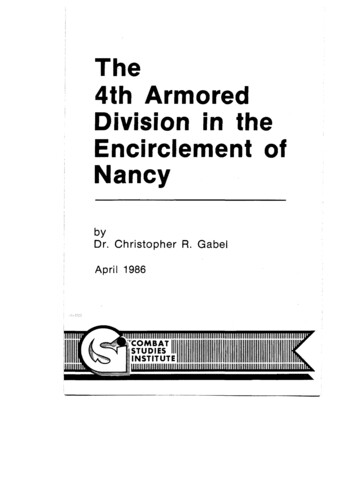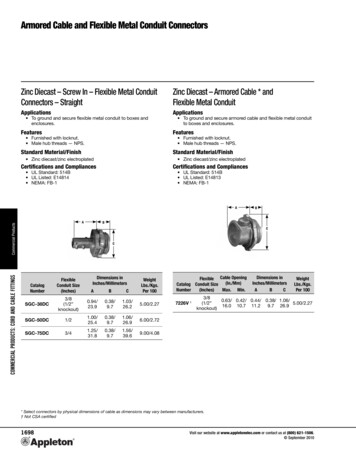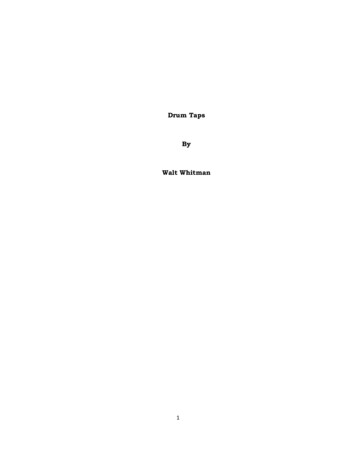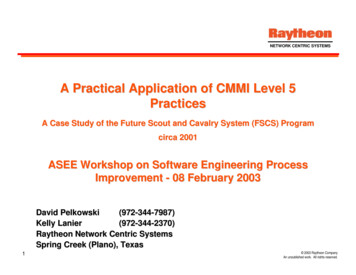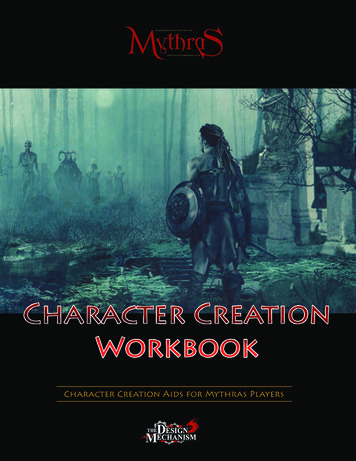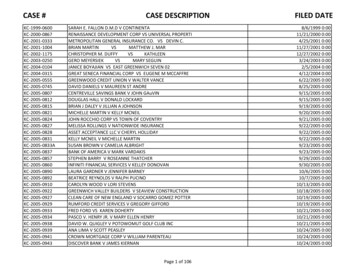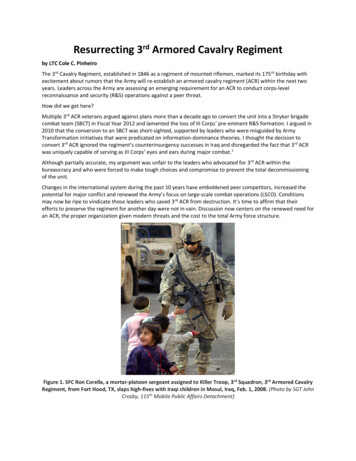
Transcription
Resurrecting 3rd Armored Cavalry Regimentby LTC Cole C. PinheiroThe 3rd Cavalry Regiment, established in 1846 as a regiment of mounted riflemen, marked its 175th birthday withexcitement about rumors that the Army will re-establish an armored cavalry regiment (ACR) within the next twoyears. Leaders across the Army are assessing an emerging requirement for an ACR to conduct corps-levelreconnaissance and security (R&S) operations against a peer threat.How did we get here?Multiple 3rd ACR veterans argued against plans more than a decade ago to convert the unit into a Stryker brigadecombat team (SBCT) in Fiscal Year 2012 and lamented the loss of III Corps’ pre-eminent R&S formation. I argued in2010 that the conversion to an SBCT was short-sighted, supported by leaders who were misguided by ArmyTransformation initiatives that were predicated on information-dominance theories. I thought the decision toconvert 3rd ACR ignored the regiment’s counterinsurgency successes in Iraq and disregarded the fact that 3rd ACRwas uniquely capable of serving as III Corps’ eyes and ears during major combat.1Although partially accurate, my argument was unfair to the leaders who advocated for 3rd ACR within thebureaucracy and who were forced to make tough choices and compromise to prevent the total decommissioningof the unit.Changes in the international system during the past 10 years have emboldened peer competitors, increased thepotential for major conflict and renewed the Army’s focus on large-scale combat operations (LSCO). Conditionsmay now be ripe to vindicate those leaders who saved 3rd ACR from destruction. It’s time to affirm that theirefforts to preserve the regiment for another day were not in vain. Discussion now centers on the renewed need foran ACR, the proper organization given modern threats and the cost to the total Army force structure.Figure 1. SFC Ron Corella, a mortar-platoon sergeant assigned to Killer Troop, 3rd Squadron, 3rd Armored CavalryRegiment, from Fort Hood, TX, slaps high-fives with Iraqi children in Mosul, Iraq, Feb. 1, 2008. (Photo by SGT JohnCrosby, 115th Mobile Public Affairs Detachment)
Purpose of an ACRThe ACR was uniquely capable of conducting a screen, guard or cover to protect an armored corps, and it couldconduct reconnaissance across the breadth of a corps to facilitate offensive maneuver. On the offense, the originalACR was built to locate and penetrate the enemy’s security zone and forward defenses while protecting friendlydivisions from enemy observation, and also while employing direct and indirect fires to preserve their combatpower.Therefore the ACR’s mission was to destroy enemy reconnaissance and advance guard units, and then locate anddestroy the enemy’s first echelon regiments.2 The ACR would then use positional advantage or direct and indirectfires to fix the lead elements of the second echelon while passing forward divisions to complete the enemy’sdestruction.In the defense, the ACR would protect the corps, delay the enemy to provide time for friendly forces, destroyenemy reconnaissance and the advance guard, attrite the first echelon and provide early warning to allow thecommander to make decisions.The need to conduct reconnaissance was inherent in all the ACR’s missions. Importantly, the ACR’s heavyorganization allowed it to gain and maintain contact with the enemy’s main body, survive, fight for informationand provide timely and accurate reporting to answer the corps commander’s information requirements, enablingthe commander to make decisions.The 2nd ACR’s role in Operation Desert Storm – and the regiment’s actions against the Iraqi Tawakalna Division Feb.26, 1991, during the Battle of 73 Easting – is the prime example of how a highly trained professional ACR can gainsituational understanding and seize the initiative for an armored corps.3Contemporary challengesRussia and China have implemented military-modernization programs to professionalize their forces and fieldadvanced technology to compete in all domains.4 Peer competitors now possess advanced reconnaissance assets(space, electronic warfare (EW), cyber, special-operations forces, unmanned aerial systems (UAS)), anti-accessarea-denial systems and long-range massed fires. The Russians in particular have streamlined their sensor-toshooter processes that allow them to rapidly detect formations and command posts (CPs) and to deliver massedlong-range fires with devastating results.5Figure 2. SPC Stephen Whitney, a cavalry scout with Headquarters and Headquarters Troop (HHT), 3rd “Thunder”Squadron, 3rd Armored Cavalry Regiment, sits behind an M240B rifle May 28, 2010, while serving on a personalsecurity detachment at the National Training Center (NTC), Fort Irwin, CA. (Photo by SGT Roger RyDell Daniels,16th Mobile Public Affairs Detachment)
The notorious Russian fires attack that destroyed a mechanized Ukrainian battalion near Zelenopillya July 11, 2014,highlights this rapid find-fix-finish kill chain. The Russians employed multiple intelligence-collection efforts toidentify unit locations and then massed rockets to destroy the concentrated Ukrainian forces.Russia’s investment in sensors and continued modernization of artillery systems is intended to extend battlefieldgeometry even farther. This will allow them to detect and destroy enemy formations at even greater ranges usingtheir integrated-fires commands.6 To counter these threats, our formations require long-range intelligence,surveillance, reconnaissance (ISR) platforms and fires. Enemy indirect fires increase the importance of dispersion,survivability and redundant communications among friendly echelons in LSCO.7The U.S. III Corps experimented by employing a traditional ACR against a modern, technologically advanced enemyduring Warfighter Exercise (WfX) 21-4 in April 2021. The ACR was comprised of an armored brigade combat team(ABCT) augmented with fires, aviation and engineers. III Corps ordered the regiment to conduct an advance guardin front of a portion of the corps, destroy enemy forces in the disruption zone and protect the trailing division fromdirect and indirect fires until the enemy’s battle zone was reached.Although WfX 21-4 was an imperfect replication of LSCO, the simulated enemy’s robust reconnaissancecapabilities, obstacle efforts, attack aviation and joint fires created significant challenges for the ACR. The exercisehas doctrine, organization, training, materiel, leadership, personnel, facilities and policy implications that suggestthe next ACR must be designed differently than its Cold War ancestor to achieve its purpose on the modernbattlefield.Figure 3. SPC Melvin Stewart, R Troop, 4th “Longknife” Squadron, 3rd Armored Cavalry, talks with the pilots afterconnecting a fuel line to an AH-64 Apache helicopter May 27, 2010, during four weeks of training at NTC. (Photoby SGT Roger RyDell Daniels, 16th Mobile Public Affairs Detachment)Previous 3rd ACRThe next ACR should not fully adopt its predecessor’s blueprints. It requires redesign to survive all forms of contactagainst a peer threat. The old 3rd ACR was organized this way:
Three ground-cavalry squadrons. Each squadron contained three cavalry troops (cavalry troop: nine M1A2Abrams tanks, 13 M3A3 Bradley Fighting Vehicles and two M1064 mortar carriers, plus headquarters,medical and maintenance sections), one tank company, an organic field-artillery battery (M109A6) and anHHT, which contained the staff, medical platoon and support platoon.An attack-aviation squadron with an assault company and aviation-maintenance company (4th Squadron,3rd ACR: 24 AH-64 Apache attack helicopters and 10 UH-60 Blackhawk helicopters).A regimental-support squadron (RSS).The regiment’s separate companies included 66th Military Intelligence Company, 43rd Combat Engineer Company(three sapper platoons and an assault/obstacle platoon) and a Bradley Linebacker battery (for air defense).The ACR was well-resourced with decentralized firepower but was short on the dismounts required to clear keyterrain to enable maneuver. The regiment knew that enemy with anti-armor systems in complex terrain was asignificant threat, and the ACR’s only solution was suppressive fire. Scenarios similar to what the Israeli DefenseForces faced in 2006 during the invasion of Lebanon were a real possibility.Intelligence collectionIf the future ACR is going to successfully conduct R&S for a corps on a deeper battlefield, the intelligencewarfighting function requires reinforcement. The ACR will likely continue to operate forward enough of thedivisions to provide decision space, but it will not physically be located in the corps’ deep area past thecoordinated fire line (CFL). If the ACR is going to contribute to the corps’ shaping efforts or inform the corpscommander’s decision-making, it must be able to see and detect enemy formations deeper on the modernbattlefield. This requires more cyber and EW capabilities at the regimental level, and more low-level voiceintercept teams to allow squadrons to gain signal intelligence across a vast front.UAS. The ACR requires a UAS capability that can range the corps’ deep area to assist in detection and delivery ofjoint fires. This UAS capability, unlike the MQ-1C Gray Eagle, should be easily launched and recovered without theuse of an airfield so that the ACR can employ it effectively while maintaining tempo in the offense. The ACR mayincorporate future semi-autonomous and autonomous ground and air sensors when they become available toextend its reach. The regiment should field small UAS at company level to enable tactical maneuver. Sensorsshould be networked so that ground-combat systems can view them, and they should support the joint forceinteroperability initiative of any sensor, any shooter.Human intelligence (HUMINT). The regiment should retain HUMINT capability to collect from the population.These intelligence capabilities will support both the ACR’s close fight and the corps’ deep fight.Force structure, organizational restructureFires. The fires complex should differ significantly from the traditional ACR. An organic field-artillery battalion issuperior to the old independent battery model because it provides a battalion commander with staff to train thefires enterprise and to assist in fires planning and execution during LSCO. The ACR can anticipate that the corpsand division commanders will place the M142 High-Mobility Artillery Rocket System and the M270 MultipleLaunch Rocket System as far forward as possible to shape their respective deep fights, normally behind the ACR’slead elements within the ACR’s support area.The ACR will clear position areas for artillery of the field-artillery brigade and should advocate for a generalsupport reinforcing relationship with those rocket battalions. Corps and division commanders will use their longrange munitions to disintegrate the enemy’s integrated air-defense systems and destroy the integrated-firescommand (IFC), but the ACR can effectively use the shorter range, less-desired M26 rockets to enable itsmaneuver.The Army’s nascent extended-range cannon artillery (ERCA) should be fielded to the ACR. Pairing ERCA with longrange sensors, including radars, would allow the ACR to range the enemy’s artillery with organic fires, which wouldhelp shape the corps’ high-payoff target list and protect the divisions from the enemy’s IFC. The regimentalcommander could attach batteries to ground-cavalry squadrons to enable operations or keep the batteriesconsolidated under regimental control to mass fires.
Finally, when the ACR is operating as the lead element of the corps’ forward-line-of-own-troops (FLOT), it shouldbe the proponent that controls the CFL’s movement to maximize the use of fires between the CFL and firessupport coordination line.Airspace. The ACR is challenged because it cannot control airspace, and this impedes responsive fires, attackaviation and joint fires. Lacking a joint air-ground integration center, the ACR can only manage airspace if a divisionallocates it to them, and the current size and composition of the regimental fires-and-effects coordination centerdoes not favor positive control of airspace. During the restructure, the Army should consider providing the ACRwith the capability to control airspace to enable responsive, deep joint and surface fires in support of the corps.Movement and maneuver. The Army should rectify the original ACR’s shortcomings when reconstituting themovement-and-maneuver warfighting function. Ground-cavalry squadrons consisting of three troops (each withtwo scout platoons and two tank platoons), a tank company and a Stryker or mechanized-infantry company wouldhave enough combat power to achieve the ACR’s original purpose. Each squadron would contain the infantryrequired to clear complex terrain or to employ anti-armor weapons to enable rapid maneuver.Army research-and-development initiatives, including unmanned ground-combat vehicles and networked UASplatforms, should be considered when modernizing the ACR. Organic mobile 120mm mortars would providecavalry troops with responsive fires to enable maneuver. The regiment’s engineer capability should include sapperplatoons for each cavalry squadron as well as redundant breaching, bridging and blade assets to enable mobilityand countermobility against an enemy with significant engineer capabilities. But the regiment may lose some digassets that standard brigade combat teams (BCTs) use for survivability in the defense. The right engineer structuremay have more capabilities than 43rd Engineers but less than a brigade engineer battalion.Air cavalry. Lastly, the ACR requires a unique air-cavalry squadron that contains three air-cavalry troops ofreconnaissance aircraft, an assault-aviation company to move infantry and supplies, a medical-evacuation sectionand an aviation-maintenance company. The regimental commander would decide how to employ the aircraft,either decentralized in support of the cavalry squadrons or as a battalion-sized maneuver element to destroy largeenemy formations.Air defense. The ACR needs more assets to protect itself from contemporary peer threats. Arrayed across thecorps’ FLOT, the ACR is extremely vulnerable to enemy air attack. This threat necessitates short-range air-defense(SHORAD) systems that are lightly armored and capable of surviving direct-fire attacks from enemy groundreconnaissance elements. The original ACR architects understood this and provided a battery of BradleyLinebackers. Future solutions may include mobile vehicle-mounted SHORAD systems and dismounted Stingerteams in the cavalry troops and infantry companies.Other assets. The ACR also requires counter-UAS systems to prevent the enemy from detecting the regiment’sformations. The increased chemical, biological, radiological, nuclear and explosives threat suggests that the ACRrequires a chemical company with a chemical reconnaissance platoon and decontamination capabilities tomaintain tempo for the corps.Impact on supportThe RSS would struggle to support this organization without restructuring. While each cavalry squadron willmaintain its vehicle fleet with its forward-support company, the RSS requires a passback maintenance capability toreconstitute combat power quickly and return it to the fight. The ACR’s position in front of the corps makesevacuating broken vehicles to a cannibalization point or trailing division-support area problematic. The RSSmaintenance company should have organic military-occupation specialty 91A, 91M and 91P mechanics to helprepair tanks, Bradleys and Paladins.This tracked mechanic capability was removed from the brigade-support battalion’s Bravo companies, but thisshould be reconsidered given the ACR’s unique mission. For the same reason, the RSS needs some heavyequipment tractor-trailer capability for recovery to the regimental-support area (RSA), even if it is only given theseassets during combat operations.
Figure 4. “Donovian” forces, depicted by Soldiers from 11th ACR, advance through the “city” of Razish at NTC,Fort Irwin, CA, March 17, 2012. The Donovian forces are used in the training environment to provide a greatersense of realism during training – 11th ACR serves as the opposing force (OPFOR) at NTC. However, the U.S.Army’s dirt combat-training centers have struggled to replicate corps and division effects. (Photo by SGT ZacharyA. Gardner, 11th Armored Cavalry Regiment Public Affairs Office)Within the ACR’s supply-support-activity platoon, the common authorized stockage listing should be more robustthan a BCT’s, and the regimental commander should be authorized to direct more lines to enable greateroperational reach.Enemy activity, displaced persons and the large volume of follow-on friendly forces will produce congested lines ofcommunication (LoCs), traffic-control problems and a priority for movement forward toward the front. The RSSshould anticipate that the expeditionary sustainment command throughput will be interrupted as resupplyconvoys pass through divisions to reach the RSA. Resupply will be delayed in LSCO as sustainment units fight topush commodities forward.Accordingly, the RSS should have water production and storage capability, greater mobile bulk-fuel capacity andmore transportation capability to carry additional Class V and commodities to prevent the ACR from culminating infront of the corps. Operating across the breadth of a corps will require the regiment to establish multiple forwardlogistics elements to support the dispersed squadrons. The extended LoCs between these sustainment nodesproduce command-and-control (C2) challenges at echelon and distribution problems as drivers are pushed to thelimits of human endurance.CPsThe ACR requires CPs that are equipped and manned to control increasingly complicated and dispersed operationsacross a vast front. CPs must be smaller, mobile, camouflaged and lightly armored to protect against artilleryshrapnel. While the Army has experimented with modular ExpandoVan-based CPs, the force requires armoredplatforms that are rapidly established and displaced, enable staff collaboration and are networked for modernsystems.The depth and breadth of the battlefield require that ACRs be manned and equipped to maintain both a main CPand a tactical CP over a long time and to be outfitted with redundancy in all command, control, communications,computers and intelligence systems to ensure C2 survivability. Directional antennas, high-frequency and highcapacity line-of-sight radios can help maintain communications in a contested environment. The contemporaryreality is that peer threats will be able to intermittently degrade communications across the spectrum.
Mission command, facilitated by a firm understanding of the commander’s intent and initiative, are fundamentalin the LSCO fight. The ACR has a role in answering the corps commander’s critical information requirements and inshaping the corps’ deep and close fights. The regimental staff should be larger and more senior than a BCT to meetthose requirements. A post-battalion-command lieutenant colonel serving as the deputy commander would assistthe regimental commander in synchronizing all warfighting functions across the regiment’s area of operations.Winners and losersThe most contentious portion of the debate is who will win and lose in any force-structure change. Branch equitiesare at stake if 3rd Cavalry Regiment converts from an SBCT to an ACR. There is pervasive concern on where Armyleadership will make cuts across the total Army force to field a modern ACR. Armor Branch, for example, has beendiscussing the importance of reconstituting division cavalry and an ACR because of the greater likelihood of majorconflict.Corps and divisions are the units of action in LSCO, and these commanders currently are overly reliant on ISR andnational assets for reconnaissance. We will likely have to shutter the ABCTs’ armored reconnaissance squadrons tomake force-structure changes, perhaps leaving the ABCT with a brigade reconnaissance troop. However, change ishard for leaders who spent the last two decades with ABCTs as the units of action. These leaders becameaccustomed to strong, responsive BCT R&S formations.Our dirt combat-training centers have struggled to replicate corps and division effects. Multiple decisive-actionrotations have conditioned BCT leaders to distrust division intelligence feeds and to value brigade-levelreconnaissance squadrons. For these reasons, a decision to move reconnaissance assets from BCTs todivisions/corps would require cultural and normative changes across multiple branches.The greatest challenge decision-makers face is determining where to make force-structure cuts and what emergingtechnologies to fund. The ACR’s maintenance cost is high and a deterrent to conversion in a budget-constrainedenvironment. In fact, maintenance cost was a determining factor in the decision to transform 3rd ACR to an SBCT.Therefore, budget is likely the largest political and bureaucratic impediment to rebuilding the ACR.Conversations across the force are converging in one aspect: a modern ACR structure should not simply mirror thestoried regiment that was disassembled in 2012. However, there is one vital element that must remain the same inthe next 3rd ACR. The troopers’ esprit de corps and aggressive mentality has been the regiment’s lifeblood for 175years and the driving force behind its many notable contributions to our nation’s defense. The regiment stillpractices its unique cavalry traditions, and its members are proud of its reconnaissance heritage.Figure 5. 278th Armored Cavalry Regiment (Tennessee Army National Guard) Soldiers test-fire their weaponsbefore entering Iraq during Operation Iraqi Freedom III. The 278th is the only ACR in the National Guard as of2017 and the only other current ACR besides 11th ACR. (U.S. Army photo)
Senior leaders should be proud that they were able to protect this from destruction a decade ago. Today 3rdCavalry Regiment is blessed with outstanding leaders and disciplined troopers who are awaiting a final decision ontransformation, and they are ready to resume their role as III Corps’ ACR.LTC Cole Pinheiro is the C2 chief, Operations Group C, Mission Command Training Program, Fort Leavenworth, KS.Previous assignments include executive officer, 2nd Brigade, 1st Armored Division, Fort Bliss, TX/U.S. EuropeanCommand; executive officer, 1st Battalion, 6th Infantry Regiment, 2nd Brigade, 1st Armored Division, Fort Bliss;operations officer (S-3), 1st Battalion, 6th Infantry Regiment, 2nd Brigade, 1st Armored Division, Fort Bliss/CampBuehring, Kuwait; commander, Company C, 1st Battalion, 67th Armor Regiment, 2nd Brigade, 4th Infantry Division,Fort Carson, CO/Arghandab River Valley, Kandahar, Afghanistan; assistant operations officer/battalion planner, 3rdSquadron, 3rd ACR, Fort Hood, TX/Mosul, Iraq; executive officer Troop K, 3rd Squadron, 3rd ACR, Fort Carson/FortHood; and tank-platoon leader, Troop K, 3rd Squadron, 3rd ACR, Fort Carson/Baghdad, Iraq. LTC Pinheiro’s militaryschools include the Command and General Staff College, Cavalry Leader’s Course, Maneuver Captain’s CareerCourse and Armor Officer Basic Course. He has a bachelor’s of science degree in international relations from theU.S. Military Academy, West Point, NY, and a master’s of arts degree in security studies from GeorgetownUniversity.Notes1CPT Cole C. Pinheiro, “The Armored Cavalry Regiment: Battle Proven and Future Primed,” ARMOR, June-August 2010.Manual 17-95, Cavalry Operations, 1996.3 Stephen Biddle, “Victory Misunderstood: What the Gulf War Tells Us about the Future of Conflict,’” International Security,Vol. 21, No. 2 (Fall 1996).4 H.R. McMaster, Battlegrounds: The Fight to Defend the Free World, New York: HarperCollins Publishers, 2020.5 Andrew Radin et al, The Future of the Russian Military: Russia’s Ground Combat Capabilities and Implications for U.S.-RussiaCompetition, RAND Corporation, 2019.6 Ibid.7 Army Doctrine Publication 3-0, Operations.2 FieldAcronym Quick-ScanABCT – armored brigade combat teamACR – armored cavalry regimentBCT – brigade combat teamC2 – command and controlCFL – coordinated fire lineCP – command postERCA – extended-range cannon artilleryEW – electronic warfareFLOT – forward-line-of-own-troopsHHT – headquarters and headquarters troopHUMINT – human intelligenceIFC – integrated-fires commandISR – intelligence, surveillance, reconnaissanceLoC – line of communicationLSCO – large-scale combat operationsNTC – National Training CenterOPFOR – opposing forceR&S – reconnaissance and securityRSA – regimental-support areaRSS – regimental-support squadronSBCT – Stryker brigade combat teamSHORAD – short-range air defenseUAS – unmanned aerial systemWfX – warfighter exercise
efforts to preserve the regiment for another day were not in vain. Discussion now centers on the renewed need for an ACR, the proper organization given modern threats and the cost to the total Army force structure. Figure 1. SFC Ron Corella, a mortar-platoon sergeant as
